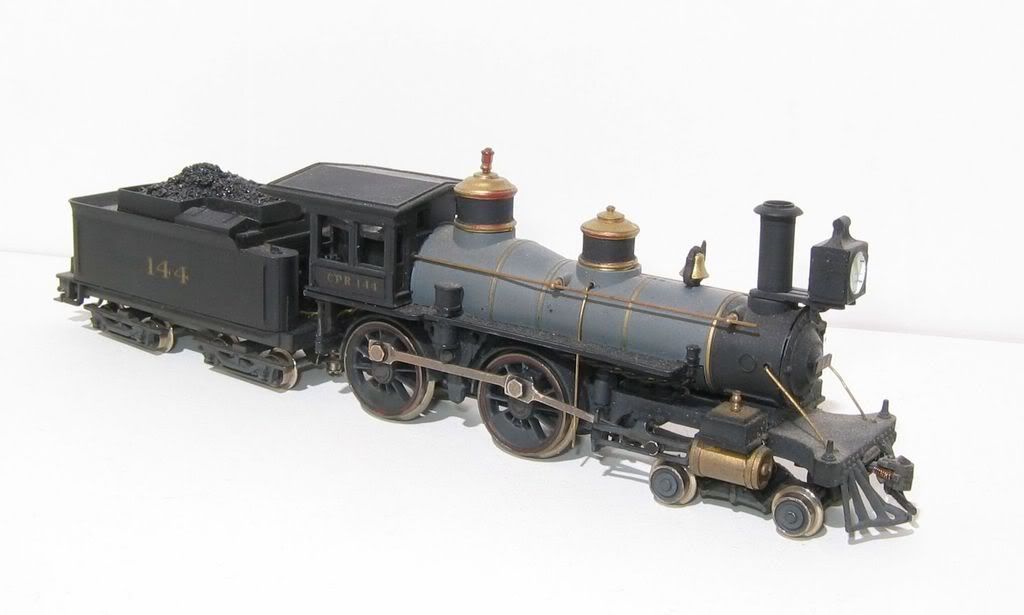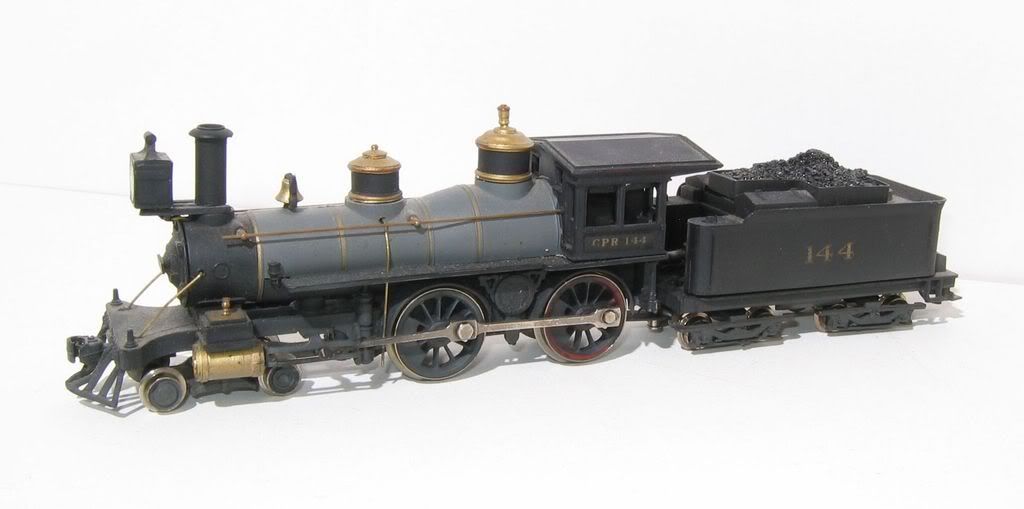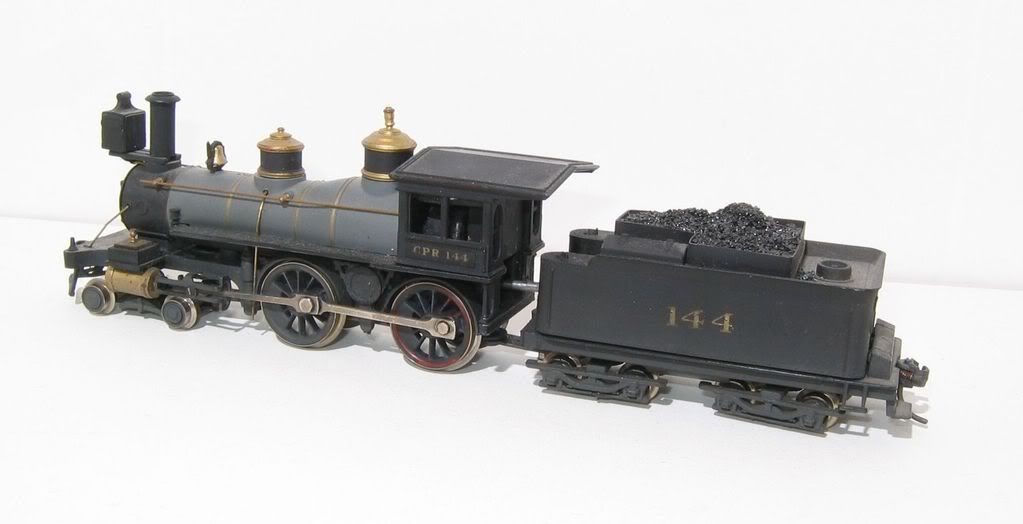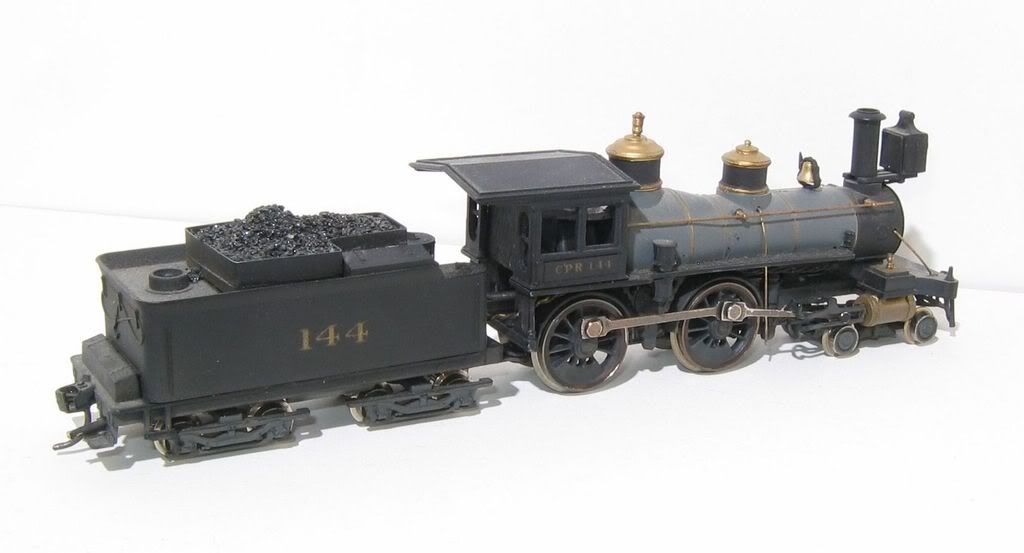Who makes a HO engine that looks most like this? Also I would like some opinions on who makes the best running 4-4-0 in DCC? # 374 down the page. Thanks. Edit: I think I fixed my link. Sorry about that.
Brent
Who makes a HO engine that looks most like this? Also I would like some opinions on who makes the best running 4-4-0 in DCC? # 374 down the page. Thanks. Edit: I think I fixed my link. Sorry about that.
Brent
Your URL displays the end of a turntable. No loco. If you mean the photo on the transitstop site titled “engine No. 136”, then there are a couple of possibilities. I think the only 4-4-0s out there are by IHC and Bachmann (Spectrum - the Plus ones aren’t even close) that are anywherenear (you’re talking a “modern” 4-4-0). I think that this one, http://www.walthers.com/exec/productinfo/160-83402 is pretty much right on (right cylinders, looks close or right on elsewhere), but Walthers says they’re out of stock, with no ETA. Check with various Internet dealers - you might get lucky.
Good luck!
Assuming the locomotive in question is CPR 374, the answer is Bachmann. While there are other options on the second-hand market, the Bachmann “golden spike” models are the only HO scale 1870-1880’s locomotives one can currently buy new.
The Bachmann-Spectrum twentieth century 4-4-0 has DCC and performs better than the “golden spike” 4-4-0, but it looks nothing like CPR 374.
I have both versions (old/new paint) of the Bachmann golden spike loco - NOT good runners!! I also have a Rivarossi #5423, road # 66, UP, that’s out of production but may be available on Ething - a very good runner. Hope this helps.[:)]
Brent,
No currently manufactured 4-4-0 looks anything like the CPR #374, which appears to be about a vintage 1880s coal burner with that diamond stack. The closest matches would be either the plastic and metal V&T Reno sold years ago by IHC (formerly known as AHM) or the brass Reno imported by PFM. The former were made by a variety of European companies such as Rivarossi (said to be the best runner) and Pocher, and in a number of different liveries and fittings, including some with diamond stacks. All were built, however, to OO scale and so are a bit oversize in HO. The PFM model was made in Japan by United and is more accurate in scale. Versions of all of them appear quite regularly on the big internet auction site at prices running from US $60-75 for the plastic models and US $200-250 for the brass.
As other posters have noted, the Bachmann Richmond 4-4-0 is a much more modern engine c. 1895-1920, and the Roundhouse 4-4-0 matches no prototype (the cab and boiler were roughly based on modernized versions of DRG narrow gauge consolidations ). Recent issues of both, however, are DCC equipped.and generally thought to run well. The Bachmann Golden Spike 4-4-0s, aside from being notoriously poor runners, represent earlier locomotives of the 1860s, that are much smaller in size and of a quite differnt outline. Still, if these interest you, you should look for some of the brass versions made back in the 1960s by PFM and Balboa, as they are better running; these too sell for about US$200-250 on the auction site.
Regards,
Frank
The new line of Bachmann old time American’s released about a year ago might be ok.
IHC had a nice lione of old time 4-4-0s a few years ago. You might find them on ebay but they are rare.
I have the UP 119 old time IHC I bought new about five years ago. Need to add track wipers on all tender wheels, plus wipers on the fireman’s side drivers. I put a Lenz decoder in it for DCC.
Here are some links to improve both. Bachmann first
http://www.pacificcoastairlinerr.com/bachmann_4-4-0/wipers/
IHC old timer
http://www.pacificcoastairlinerr.com/1879/locomotives/big_wheels/
I have done both mods including with a Mantua General.
The Spectrum 4-4-0, about 1905 to 1910 vintage, is nice if you want to go with a little later era.
Rich
Which begs the $64K question? Why aren’t more models of 4-4-0s made? My guesses:
Model railroaders are, for the most part, firm believers in “bigger is better”. More space, longer trains, bigger engines.
In the smaller scales, it is easier (and actually cheaper because of the easier) to design and engineer larger locomotive models than models of small prototypes. There is room in the larger models for value-added (and more profitable) features such as flywheels, cheap but decent motors, sound systems, etc.
Model railroaders are willing to pay based on the number of wheels on a locomotive. A Big Boy can sell for 4X the price of a 4-4-0, despite actual production costs being quite close for equivalent quality levels. The raw materials for the bigger boiler and tender castings are really negligible. The result is that most model 4-4-0s have had pretty poor drives in comparison to their articulated equivalents.
Saturation steam 4-4-0s reigned supreme in the 19th Century, and were widely used through about 1915. The arrival of super heaters and heavier cars and trains doomed them. Virtually none survived to the popular transition era.
There are fewer exciting steam modelers than there are depressing diesel modelers. And there are many fewer modelers modeling the pre-1920 era than there are modeling the 1950s last years of steam.
Despite all the above, MMI is going ahead with their Baldwin 8-18C/D&RG Class 42 in HOn3, On3, and On30. It took MMI several years to get sufficient orders to justify the project. Design (final price is still TBD) is based on a price point of $500 for the HOn3 version. I can here everybody now - $500
I think Fred W did the best job of exlaining the lack of 19th century locomotive power of anyone I have seen on this (or any other) forum. As an avid modeler of the late 1800’s I am as frustrated as the next guy over the apparent lack of interest, by major manufacturers, in this the Golden Age of railroading. I have owned 4-4-0s from Bachmann (old style), IHC, Rivarossi as well as brass models from Gem and Kidder. All of these didn’t run worth a darn! Over the past two years I decided to try/buy a couple of the new Bachmann Spectrum locomotives. What a difference!! These are sweet-running engines that are capable of pulling appropriately sized trains. Unfortunately they are of a later period than the 1890s, With nothing else in sight…who cares? As it is I pull redecorated Roundhouse rolling stock that would more correctly fit the very early 20th century (they are too long among other things).
Thank God at least Bachmann gives us one example of the engine that made America’s railroads (although I would kill for a woodburner or a mogul). If you persist in modeling the Civil War years; you are basically out of luck. I suppose a really talented person could back date the Bachmann Spectrum units - but that would be quite a project (the locomotives are too large anyway). I guess those of us of mediocre talent will just have to wait to see what comes on the scene. In this economy: don’t hold your breath.
Ray
Fred W & CNErunner both hit it!! I belong to the Civil War Modelers Group, and it seems that other than the IHC’s, which need major work, most of the members are rebuilding the Tyco Generals!!! As we’ve discussed many times here, thre is a sad lacking of much equipment earlier than the 1930’s or so!![:(]
Well the lack of 1800’s stuff is disappointing indeed. I think I will go with the extra track wipers when I pick one up. Thanks for the link Rich. I just wanted to get an old 4-4-0 and a couple of old time coaches to run around on the pike unattended when the house is full of company as it often is. I thought if I put that on the layout at 20 mph. It would keep the guest occupied while I tend to the barby. I could really be happy modeling the 1800’s if there were more things from that era to spend my hard earned money on. (Hmmm maybe that’s why SWMBO keeps suggesting I model the 1800’s[:D])
Brent
Here are some photos of my old Rivarossi 4-4-0. I added a pickups to the first coach and run a wire to the loco for additional pickup.
Some minor changes include a Roundhouse/MDC headlight, shortened draw bar and drive shaft to tender, reshaped front pilot, coal load in tender, extra weight in cab roof area for better balance and pulling power.




